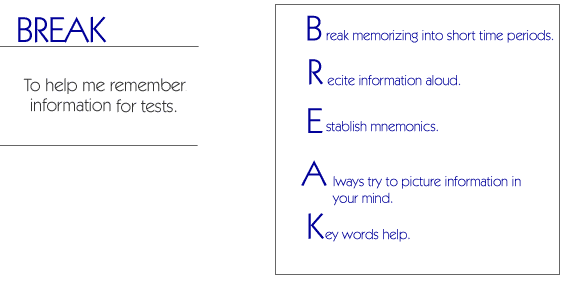B
reak memorizing into short time periods.
- Never try to memorize a lot of information
at one time. This leads to overloading and your mind won't let
you memorize any more information. Or it leads to boredom and
you can't get motivated to keep working on memorizing.
- Try to arrange short, frequent blocks
of time for memorization. Spend a specific amount of time working
on methods to memorize some information and then review these
methods at certain times throughout your studying time. For
example, you may devote 10 minutes to memorizing your Spanish
vocabulary at the beginning of a two hour block of studying,
and then 10 minutes in the middle and another 10 minutes at
the end. This will give you 30 minutes of studying your Spanish
vocabulary. It is less effective to spend 30 minutes at one
time working on the vocabulary because of overloading and boredom.
It's easier to work on it in short time periods spaced out over
time.
- Never cram! Don't try to memorize information
you haven't worked on right before a test. If you do, this will
make you anxious. However, before a test you should review memorization
techniques that you have been using while studying.
|
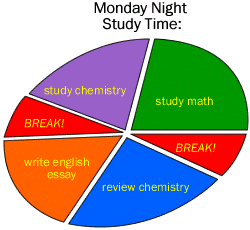
|
R
ecite information aloud.
- Read aloud the note cards you are studying from. Read the
questions on one side and then the answers on the other side.
- After reading aloud, test yourself on the information by
shutting your eyes and asking and answering the questions again.
- If you get the answer wrong, write it several times as you
say it over and over.
|
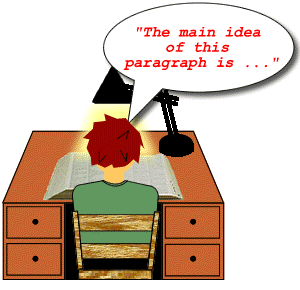
|
E
stablish mnemonics to help
you remember information.
- Mnemonics are words and letters that
help you remember information.
- To make up a mnemonic, make a list
of the important facts you need to remember. Use the first letter
of each fact to make up another word that will help you remember
the ideas to be memorized. For example, the mnemonic HOMES was
created to help students remember the names of the Great Lakes.
- First, the Great Lakes were listed:
Superior, Michigan, Huron, Erie, Ontario.
- Next, the first letter of each
word was written separately: S, M, H, E, O.
- Then, the letters were moved around
to create a key word that would remind you of the names
of the five Great Lakes.
- The word HOMES was created using
H (Huron), O (Ontario), M (Michigan), E (Erie), and S (Superior).
- Another type of mnemonic involves using
the first letters of the words or ideas to be memorized to create
a "catchy" sentence. The sentence does not have to
make sense as long as it sticks in your mind and you can remember
it when taking a test. Using the first letters of the five Great
Lakes: M (Michigan), H (Huron), S (Superior), O (Ontario), E
(Erie), the following sentence can be made: "Monkeys have
seven orange ears".
- It is very important that you can recall
these mnemonic techniques when taking a test. Write down the
key word (HOMES) or catchy sentence (Monkeys have seven orange
ears) in the margin of your test and then analyze the letters
as an aid to recalling the facts.
|
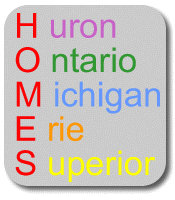
|
A
lways try to picture in your mind
words or pictures to help you remember.
- As you study, try to visualize (or
picture in your mind) words and pictures that will help you
remember. For example, if you are trying to remember the parts
of an animal cell, you may picture in your mind the diagram
from your science book where the different parts were shown.
If you used graphic organizers to help you learn, picture the
graphic organizer in your mind and then recall each of the parts.
- After looking at the picture or graphic,
shut your eyes and try to recall as much detail as possible.
If you can't recall all the details, study the picture or graphic
again, and then shut your eyes and repeat the process. Do this
until you can recall all parts to be memorized.
- When answering a test question involving
material you visualized, shut your eyes for a second and try
to recall all aspects of the picture or graphic in your mind.
|
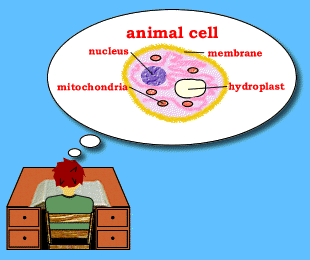
|
K
ey words help.
- If you have to memorize words or facts that are new or hard
for you, it may help to associate these with key words. For
example, if you can't recall the meaning of the word ziggurat
(a temple built in a series of terraces with each terrace smaller
than the one below with a staircase and a shrine on top) for
a world history test, look at the word to find something that
is related to the meaning. The small word zig appears in the
word and the series of terraces zig-zag up.
- It is best to combine key word approach with visualizing.
Once you identify a key word, picture in your mind a relationship
between the key word and the original word (picture the zig-zag
pattern of the ziggurat).
|
 |
|

